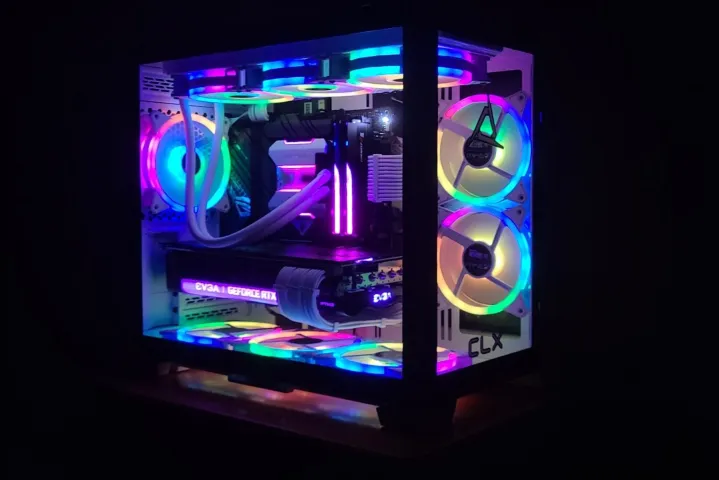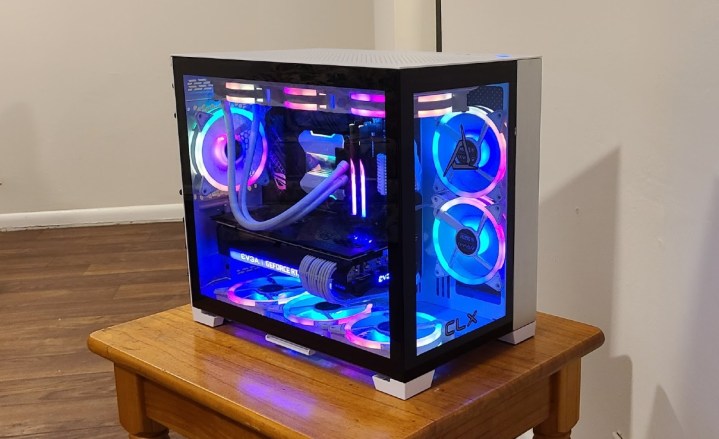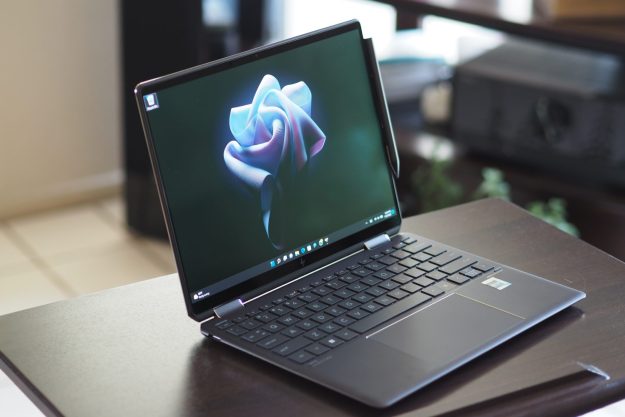
“The CLX Scarab is a worthy choice for gamers who want a high-end PC that games well and looks clean.”
- Great cable management
- Plenty of customization choices
- High performance out of the box
- User upgradable
- Expensive, especially for cheaper configurations
- Some oddities with the case
CLX is a boutique PC builder you may not have heard of. It’s only been around for six years, but is attempting to challenge some of the bigger names out there such as Origin PC, Falcon Northwest, and Digital Storm — all brands that let you customize your desktop build down to each component.
I’m reviewing CLX’s Scarab PC, which is one of the company’s most premium desktops. Equipped with up to a Core i9-12900KS and an RTX 3090, it certainly has top-of-the-line specs. It’s not perfect, but this system’s smart part selection, meticulous cable management, and attention to detail makes the Scarab one of the highest-quality gaming PCs on the market.
Design

The Scarab PC that CLX configured for us uses a black-and-white color scheme with an emphasis on contrast, and it looks really nice. On the outside, the chassis is white, while the glass panels have a black bezel; on the inside, the PSU power cables, the AIO cooler, and RGB fans are white, and the motherboard and GPU are black. The retail version of this case doesn’t have black bezels around the glass panels, which means CLX modified it. That’s just one example of CLX’s attention to detail with the Scarab.
Of course, like many other gaming PCs, the Scarab has tons of RGB fans, and while I’m not a huge fan of RGB personally, it’s quite a light show. Nine fans is probably overkill, though, even for a 12900K and a 3090. Thankfully, the Scarab comes with a remote that controls both the RGB and the fans, though I do have a couple of issues with it.
I would have loved even more control, such as being able to turn the fans down quieter or toggle off RGB entirely. There are also no fan speed profiles either, which would have been more convenient than just an increase and decrease button.
The Scarab gets almost everything right; this is a really nicelooking and tidy machine.
The Scarab uses the Lian Li O11 Dynamic Mini Snow White, and I have mixed feelings about this case. It looks sharp and has plenty of room on the inside, but there are some oddities about it. The front and side glass panels can’t be removed without removing a panel on the top of the PC, and putting the panels back on can be a bit of a hassle.
I had a particularly hard time removing and reinstalling the back panel and, surprisingly, the back panel doesn’t even have captive screws. At least on my unit, the power button is also strangely loose and off-center. I know this is nitpicky, but when a PC costs $5,000, you expect perfection. I would have liked CLX to take one more step and make its own custom chassis so that it can have a bit more control over the design and quality of its PCs. Falcon Northwest’s Talon has a unique case for its $5,500 prebuilt, and not only does it look impressive, it has fine internal design as well.

This case also has a ton of thumbscrews and screws, especially at the back where the motherboard ports are. There are just too many screws and panels to remove. From what I can tell, there’s even one small removable panel that doesn’t seem to have a point.
Another panel can open access to the HDD bay, but I couldn’t pull out any of the HDDs farther than you can see in the above image. While Lian Li was trying to design the HDD bay to be easily accessible, in practice, I had a hard time figuring out how in the world I would even get a HDD in or out. I wish CLX had just chosen a more normal chassis.
The only other substantial complaint I have about the Scarab is the thermals. It’s not CLX’s fault that the Core i9-12900K draws a ton of power and isn’t easy to cool, but it always ran at 100-degrees Celsius in any sustained CPU workload. I would have liked to see a custom liquid cooling option for the Scarab so that CPUs like the 12900K wouldn’t look so worrying, and PCs like the EK 275 Conquest certainly prove that a prebuilt can come with a custom liquid cooling solution at this price point. But aside from, the Scarab gets everything else right; this is a really nice-looking and tidy machine.
Specs and pricing
The CLX Scarab doesn’t use any proprietary hardware, which means it’s just as upgradeable as any DIY PC. It’s also worth noting that you can customize pretty much any part of the Scarab, so the PC we’re reviewing is just one of many possible configurations.
| CPU | Intel Core i9-12900K |
| GPU | EVGA GeForce RTX 3090 FTW3 |
| Motherboard | ASUS ROG Strix Z690-G Gaming WiFi |
| Case | Lian Li O11 Dynamic Mini Snow White |
| Memory | 32GB G.Skill DDR5-5600 |
| Storage | Samsung 980 Pro 1TB, Seagate Barracuda 4TB |
| Power supply | Silverstone SX1000 |
| USB ports | 4x USB 3.2 Gen 1, 2x USB 3.2 Gen 2, 1x USB-C 3.2 Gen 2×2, 1x USB-C 3.2 Gen 2 |
| Networking | 2.5 Gigabit Ethernet, Wi-Fi 6E |
CLX offers an impressive amount of hardware options that cover every segment from the low end all the way to the top end, and not only do they offer several different Intel CPUs and Nvidia GPUs to choose from, but also AMD hardware. You could configure the Scarab with a Ryzen 9 5950X and an RX 6950 XT if you prefer AMD, for instance.
Don’t bother ordering a Scarab unless you’re willing to shell out for the top-end parts.
Another benefit of the Scarab using retail hardware is that you can’t really be surprised with how a specific component is going to perform. If you’re not sure about the CPU cooler or the storage for example, then you can just find a review and judge for yourself. This benefit isn’t unique to the Scarab (especially as more and more prebuilt models are getting away from proprietary hardware), but it’s still worth mentioning.

The Scarab’s only real problem is the price. At $5,000, our configuration is really expensive, and since this is made using off-the-shelf parts, you could build yourself basically the same thing for around $3,500. We don’t expect PCs this expensive to be particularly great value, though. The HP Omen 45L has a very similar spec sheet for about the same price, so CLX isn’t charging much more than its competitors.
Pricing at CLX varies depending on the market, so although this PC was $5,000 when we received it, by the time of writing, the price has decreased to $4,600. On the other hand, prices could increase rather than decrease, but a difference of a few hundred dollars isn’t very large for a multi-thousand dollar PC.
A lack of value might not bother someone with a $5,000 budget, but this is definitely a problem for someone who might be interested in an upper-midrange PC such as the MSI Aegis RS 12, which has a Core i7-12700K and an RTX 3070. It costs $2,200 while a similarly configured Scarab goes for nearly $3,300. The Aegis is by no means a perfect PC, but $1,100 is a ton of money to spend on what is basically quality assurance. Don’t bother ordering a Scarab unless you’re willing to shell out for the top-end parts like the Core i9-12900K and the RTX 3090. The premium is simply too much.
Internals and upgradability
When it comes to the inside of the PC, CLX did a decent job overall. The main chamber where the motherboard and GPU are located have excellent cable management, making the Scarab not only one of the neatest-looking PCs I’ve ever seen, but definitely neater-looking than my own. The white braided PSU cables are especially nice to see, and definitely look better than the standard black cables that I see in my own.

The back of the PC is different, however. In order to build a PC that has a top-end CPU, top-end GPU, nine fans, and two RGB hubs for all those fans, CLX ended up using a ton of cables. If most of the length of those cables aren’t visible in the main chamber, you can probably guess where they ended up: stuffed in the back.
While I am impressed with how neatly these cables are jammed into a small area that’s probably designed for holding excess cables anyways, there are so many that it’s going to be difficult working on this PC if you ever need to do something that requires adding or removing cables, like upgrading a component.
Speaking of upgrading, the Scarab is basically just like any normal DIY PC since it’s made from parts you could buy at retail. Because the specific model we’re reviewing has a 600 series Intel motherboard, you don’t even need to replace anything but the CPU in order to upgrade to the upcoming 13th Gen CPUs based on Raptor Lake, which is good because it means you don’t need to deal with all the cables. Upgrading the GPU should also be relatively easy thanks to all the room in the chassis, and you might not even need to worry about cables if your hypothetical next card uses the same amount of power plugs.
Performance
When it comes to productivity applications and other programs, this specific model of the Scarab does very well thanks to its top-end specs. The Core i9-12900K is overall the fastest CPU you can buy and the RTX 3090 is tied for the fastest GPU, up there with Nvidia’s own RTX 3090 Ti and AMD’s RX 6900 XT and 6950 XT.
| CLX Scarab (Core i9-12900K) | Origin Neuron (Ryzen 9 5950X) | HP Omen 45L (Core i9-12900K) | |
| Cinebench R23 multi-core | 26496 | 25,166 | 23,068 |
| Cinebench R23 single-core | 1925 | 1,587 | 1,893 |
| Geekbench 5 multi-core | 18405 | 15,872 | 15,685 |
| Geekbench 5 single-core | 1959 | 1,682 | 1,910 |
| PugetBench for Premiere Pro | 1139 | 1,088 | 1,025 |
| Blender average (in seconds, lower is better) | 125 | N/A | N/A |
| Handbrake (in seconds, lower is better) | 46 | 50 | 51 |
| PCMark 10 | 9063 | N/A | 9,034 |
Against the Origin Neuron, which uses the Ryzen 9 5950X, the Scarab scores small victories in multi-threaded applications and big wins in single-threaded workloads. That’s about what we expect for this matchup, though the 12900K does consume quite a bit more power to obtain this level of performance.
Although I did express my disappointment about the Scarab’s lack of custom liquid cooling, I wasn’t saying it’s lacking compared to other desktops. The HP Omen 45L, which made our list for best gaming desktops, is noticeably slower than the Scarab despite the fact that both have the same CPU, the 12900K.
While 100 C is certainly a temperature I don’t like seeing, the performance is certainly strong.
The reason is pretty clear: the 45L’s 240mm AIO just isn’t enough to tame the 12900K. This is also compounded by the 45L using DDR4 rather than DDR5 like in the Scarab, though that’s not relevant in every benchmark; in Cinebench, the performance difference is down entirely due to lower CPU clock speeds on the 45L.
The 360mm AIO cooler is especially crucial for the Scarab as CLX has enabled Multi-core Enhancement or MCE on the 12900K. This basically removes many of the power and thermal limits on the CPU so that it can just boost forever, or at least until it hits 100 C. While 100 C is certainly a temperature I don’t like seeing, the performance is certainly strong.
Against other 12900K-equipped PCs, as well as PCs that opt for Ryzen, this model of the Scarab is never in last place. At worst, it’s just tied for first or barely in the lead. However, I can’t say this is truly the fastest the 12900K can get, because in our own testing, we found that the 12900K could reach over 27,000 points in Cinebench R23 multi-core, which is a bit higher than the Scarab achieved.
Gaming performance

Despite having identical hardware to the Omen 45L, the Scarab maintains a lead in Assassin’s Creed Valhalla and Red Dead Redemption 2. I should note, however, that the Neuron and 45L were tested a few months ago on older drivers, which could have given an advantage to the Scarab. But even if that’s the case, we’re talking about a few more frames, not an extra 10 or 20 for the other desktops. The Scarab is clearly a bit faster here, or at worst, tied for first place.
One thing to note is that these are 4K, max quality settings benchmarks, and the Scarab only dipped below 60 frames per second (fps) in Cyberpunk 2077. It’s not shocking that it’s getting 220 fps in Civilization VI, but its performance in Assassin’s Creed Valhalla and Red Dead Redemption 2 is definitely impressive, and for people who prefer better visual fidelity, the frame rate is high enough.
| CLX Scarab (RTX 3090) | Origin Neuron (RTX 3080 Ti) | HP Omen 45L (RTX 3090) | |
| Assassin’s Creed Valhalla | 69 fps | 55 fps | N/A |
| Red Dead Redemption 2 | 84 fps | 72 fps | 76 fps |
| Civilization VI | 220 fps | N/A | N/A |
| Fortnite | 82 fps | 89 fps | 82 fps |
| Cyberpunk 2077 | 50 fps | N/A | N/A |
| 3DMark Fire Strike | 41122 | N/A | N/A |
| 3DMark Time Spy | 20791 | 17397 | 18523 |
If you were to aim for really high frame rates like 240fps or more, you shouldn’t have any problems with the Core i9-12900K, one of the fastest gaming CPUs. You could also choose a configuration using the Ryzen 7 5800X3D, which is just as fast in games while costing significantly less than the 12900K.
In 3DMark’s Time Spy benchmark, we see basically the same thing we saw in gaming benchmarks. With over a 2,000 point lead, the Scarab is about 10% faster than the 45L, which is pretty impressive given they use the same CPU and GPU. Cooling is really important, and while I think nine fans is overkill, they’re certainly proving their worth.
Given the Scarab’s price, it’s good that it’s at the top of the charts (and it kind of needs to be). This is definitely one of the fastest PCs we’ve ever tested, and CLX has done an admirable job making sure the 3090 has the thermal headroom to perform the best it can.
Our take
The CLX Scarab is a high-performing and stylish gaming desktop that’s only held back by the cost of buying one. While CLX has put much care into assembling this PC, the premium is hard to justify unless you’re choosing top-end parts. Still, you can expect excellent performance from the Scarab if you configure one like our review unit, and that certainly makes it stand out from other prebuilt offerings.
Are there any alternatives?
The top-end HP Omen 45L is a similarly priced and configured PC, featuring the same Core i9-12900K CPU and a RTX 3090 GPU, but falls a bit behind in performance due to lower frequencies.
If you’re going with top-end parts like these, it’s hard to not choose the Scarab. If you’re looking for better value however, there’s the Origin Neuron, which is just a bit slower for half the price while having comparable build quality.
How long will it last?
This particular configuration of the Scarab should last quite a while. The 12900K and 3090 are both very powerful parts that won’t be considered slow any time soon, and there’s plenty of room for adding more storage and RAM. Intel’s 600 series motherboards will also support upcoming 13th-gen Intel Raptor Lake CPUs, which gives you a bit of an upgrade path even if you have a 12900K. These boards will also support PCIe 5.0 GPUs, though for most users that probably won’t be a big deal.
Should you buy it?
Yes, but only if you’re choosing top-end parts like the Core i9-12900K or the RTX 3090. The Scarab is simply too expensive if you configure it as a midrange PC and can cost over a thousand dollars more than value-oriented gaming desktops with the same components.
Editors' Recommendations
- No, The Last of Us PC requirements aren’t changing
- The most demanding PC games that push your rig to the limit
- Nvidia just fixed a major problem that may have slowed down your CPU
- Windows 12: the top features we want to see in the rumored OS
- If you have an Nvidia graphics card, your CPU may be suffering right now





